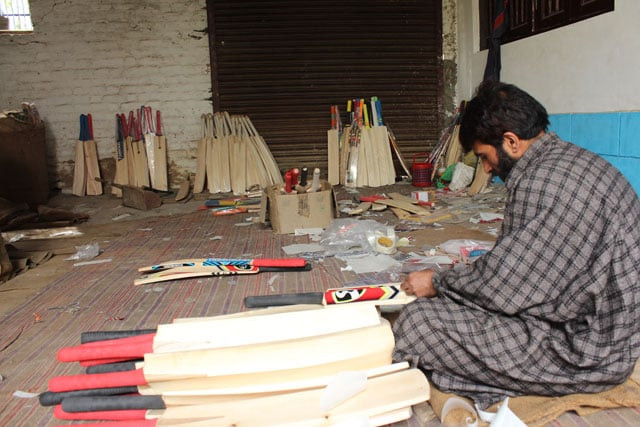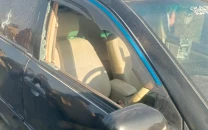All out: Indian Kashmir’s declining bat industry
After the flash floods of 2014, the bat industry in Kashmir has been battling for survival

PHOTO: Shabir Bhat
Before Partition, hand crafted clefts from Kashmir, including those made from local willow trees, were transported to Sialkot, one of Asia’s biggest sports centres located southwest of the Himalaya foothills. After Independence, however, Kashmir’s cleft makers turned towards newly established centres in Jalandhar and Meerut as demand for cricket bats in India increased over time. They were making a sizeable profit before the flash-floods in November 2014 swept everything in its path. Today, the industry struggles to stay alive.
The devastating deluge
In Kashmir, over eight villages, comprising Charsoo, Jawbhara, Halamulla, Bijbehara, Sangam, Sethar, Mirzapor and Pujteng in the South Kashmir, are considered the hub of bat manufacturing. From Pulwama to Anantnag billboards have been installed over showrooms and mechanised factories have been set us to impress potential buyers.
 PHOTO: Shabir Bhat
PHOTO: Shabir BhatBut little work goes on inside the factories nowadays. “Before the floods, we sold around 10,000 bats every year and our annual expenditure was around INR2,000,000,” mentions 24-year-old Shahid Majeed, son of M Sons and Sports owner in Charsoo. “After the floods we are only able to send 5,000 bats annually but the preparations too don’t follow as planned. Most of the units struggle for long-run survival,” he adds.
In September 2014, bat owners piled up stocks in hopes to sell them during the One-day International World Cup, but their entire stock was washed away by the gushing waters. Since then, the makers struggle to secure orders for their bats, and to add to their misery even the government has failed to assist them.
 PHOTO: Shabir Bhat
PHOTO: Shabir BhatBashir Ahmad Wani is another affected bat-maker running one of the oldest units, Bashir Sports Industry (BSI), that was started by his forefathers in 1965 in Bijbehara town. After the floods, production of BSI bats gravely declined. Between 2012 and 2013, production was close to 35,000 bats, but after 2014 the unit only churned out 8,000 bats. “Why does our government not issue us export licenses?” laments 35-year-old Wani. “The industry has the potential to create over 15,000 new jobs by introducing its own production-cum-process developing centres,” he informs. He further mentions that most of his bats are sold to companies such as SS Ton Gladiator, Gunn and Moore and Sanspareils Greenlands. During the floods, he lost 6,800 willow clefts and the damage to his machinery, including raw material, estimated to INR3,000,000.
 PHOTO: Shabir Bhat
PHOTO: Shabir BhatSimilarly, the annual turnover of M Sons and Sports used to be over INR5,000,000 but now it’s partially shut since the last seven months with only two labourers working inside the factory. The unit barely produces 10,000 bats and fetches between INR8,000,000 to INR1,000,000 annually.
During the floods, factories remained drowned for days under eight to thirteen feet of water, recalls former president of Cricket Bat Manufacturers Association (CBMA) Nazir Ahmad Salroo. “The industry has suffered massively after the raw material got washed away,” says Salroo. The extended exposure to flood waters ruined the uncut trees as well. “Thousands of clefts became useless after they changed colour and there was extensive damage to the light and heavy machinery. There seems to be no demand for the Kashmir willow anymore,” he adds.
Meanwhile, the cost of stickers, lamination rubber used for grip and chemicals used for polishing the blades also rose, translating into higher production costs. As a result, most owners have shut down their units. Currently, there are about 300 registered and 100 unregistered large, medium and small bat-manufacturing units providing direct and indirect employment to approximately 40,000 workers in Anantnag district alone. Most of these are in small and medium scale enterprises that employ 10 to 40 people per unit and only 50% of these units use proper machinery. Moreover, unavailability of electricity in Kashmir also acts as a deterrent to augmentation of mechanisation in the industry.
No good season for work now
In 1989, to promote local sports goods, the Jammu and Kashmir government had banned the transport of willow outside the state. But the Jammu-Pathankot highway continued to facilitate the smuggling of clefts into Punjab and Uttar Pradesh. About 50% of total production is exported to Meerut, Kolakata and Jalandhar through middle men and the remaining products are sold across Kashmir. “The bats are then exported from these cities to Australia, South Africa, England and Bangladesh,” says Ghulam Qadir Bhat, the President of CBMA. According to officials, only if the government provides the right business opportunity to bat manufacturers in Kashmir the units will flourish and contribute to economic growth by 15%.
 PHOTO: Shabir Bhat
PHOTO: Shabir BhatIn 2008 the government set up a seasoning plant at Sethar, costing nearly INR50,700,000, to hasten the process of reducing moisture levels in clefts, which if kept in the open air takes over eight months to dry completely. Over 15 wood seasoning chambers, four boilers and one solar based chamber were installed to improve the quality of bats in order to make them internationally compatible. But according to owners of manufacturing units the plant was nothing more than a waste of money and time as it was never operational after its inauguration.
Before the floods, the then Minister of State for Industries and Commerce, Sajad Ahmad Kichloo, had even announced the Sports Complex at Bijbehara would promote the bat industry and ensure adaptation of new techniques for manufacturing to compete with other groups in India. The plan, however, was never implemented. In fact, in the past, the government had also announced the set-up of an industrial cluster for the bat-making industry, which has yet to see the light of the day.
Soon after the floods a proposal was sent to the government of India for relief and rehabilitation of affected industries. Recently, Kashmir’s Director of Industries and Commerce Department, Nazim Khan, sought compensation of around INR250,000,000 for flood-hit industries.
 PHOTO: Shabir Bhat
PHOTO: Shabir BhatIn reality, however, there has been little support from the government and manufacturers affirm the industry is declining rapidly. According to the CBMA, damage caused to the willow trees could also result in a shortfall of around 700,000 bats until 2020. The loss estimated by willow suppliers is around INR10,000,000.
Wind in the willows
During the India tour, Australian cricketers used Kashmir willow bats for practice and signed autographs on September 4, 1979, for Dar Sports, one of the oldest units with the tagline ‘The Name in Grace’. There is a great demand for these bats worldover as Kashmir willow is comparatively cheaper and considered to be of the finest quality, after English willow.
Despite the losses and difficulties, some people are optimistic the industry can pull through. Recently, Sarfraz Khan, who plays for Royal Challengers Bangalore in the Indian Premier League, used a Kashmir willow bat in the tournament after visiting a unit in Srinagar.
Tahir Ibn Manzoor is a freelance sports journalist based in Baramulla. He tweets @TahirIbnManzoor
Shabir Bhat is a freelance photojournalist from Pulwama area of Jammu and Kashmir. He tweets @ButtShabir



















COMMENTS
Comments are moderated and generally will be posted if they are on-topic and not abusive.
For more information, please see our Comments FAQ